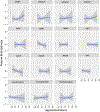Parental preconception exposure to phenol and phthalate mixtures and the risk of preterm birth
- PMID: 33640694
- PMCID: PMC8488320
- DOI: 10.1016/j.envint.2021.106440
Parental preconception exposure to phenol and phthalate mixtures and the risk of preterm birth
Abstract
Background: Parental preconception exposure to select phenols and phthalates was previously associated with increased risk of preterm birth in single chemical analyses. However, the joint effect of phenol and phthalate mixtures on preterm birth is unknown.
Methods: We included 384 female and 211 male (203 couples) participants seeking infertility treatment in the Environment and Reproductive Health (EARTH) Study who gave birth to 384 singleton infants between 2005 and 2018. Mean preconception urinary concentrations of bisphenol A (BPA), parabens, and eleven phthalate biomarkers, including di(2-ethylhexyl) phthalate (DEHP) metabolites, were examined. We used principal component analysis (PCA) with log-Poisson regression and Probit Bayesian Kernel Machine Regression (BKMR) with hierarchical variable selection to examine maternal and paternal phenol and phthalate mixtures in relation to preterm birth. Couple-based BKMR model was fit to assess couples' joint mixtures in relation to preterm birth.
Results: PCA identified the same four factors for maternal and paternal preconception mixtures. Each unit increase in PCA scores of maternal (adjusted Risk Ratio (aRR): 1.36, 95%CI: 1.00, 1.84) and paternal (aRR: 1.47, 95%CI: 0.90, 2.42) preconception DEHP-BPA factor was positively associated with preterm birth. Maternal and paternal BKMR models consistently presented the DEHP-BPA factor with the highest group Posterior Inclusion Probability (PIP). BKMR models further showed that maternal preconception BPA and mono(2-ethyl-5-hydroxyhexyl) phthalate, and paternal preconception mono(2-ethylhexyl) phthalate were positively associated with preterm birth when the remaining mixture components were held at their median concentrations. Couple-based BKMR models showed a similar relative contribution of paternal (PIP: 61%) and maternal (PIP: 77%) preconception mixtures on preterm birth. We found a positive joint effect on preterm birth across increasing quantiles of couples' total mixture concentrations.
Conclusion: In this prospective cohort of subfertile couples, maternal BPA and DEHP, and paternal DEHP exposure before conception were positively associated with preterm birth. Both parental windows jointly contributed to the outcome. These results suggest that preterm birth may be a couple-based pregnancy outcome.
Keywords: BPA; Couple; DEHP; Preterm; Singleton; Subfertile.
Copyright © 2021 The Authors. Published by Elsevier Ltd.. All rights reserved.
Conflict of interest statement
Declaration of interests
The authors declare that they have no known competing financial interests or personal relationships that could have appeared to influence the work reported in this paper.
Figures




Similar articles
-
Association of preconception mixtures of phenol and phthalate metabolites with birthweight among subfertile couples.Environ Epidemiol. 2022 Aug 31;6(5):e222. doi: 10.1097/EE9.0000000000000222. eCollection 2022 Oct. Environ Epidemiol. 2022. PMID: 36249269 Free PMC article.
-
Association between co-exposure to phenols and phthalates mixture and infertility risk in women.Environ Res. 2022 Dec;215(Pt 1):114244. doi: 10.1016/j.envres.2022.114244. Epub 2022 Sep 2. Environ Res. 2022. PMID: 36058272
-
Maternal and paternal preconception exposure to phenols and preterm birth.Environ Int. 2020 Apr;137:105523. doi: 10.1016/j.envint.2020.105523. Epub 2020 Feb 29. Environ Int. 2020. PMID: 32120140 Free PMC article.
-
Maternal exposure to endocrine disrupting chemicals (EDCs) and preterm birth: A systematic review, meta-analysis, and meta-regression analysis.Environ Pollut. 2022 Jan 1;292(Pt A):118264. doi: 10.1016/j.envpol.2021.118264. Epub 2021 Oct 1. Environ Pollut. 2022. PMID: 34606968
-
Association of BPA exposure during pregnancy with risk of preterm birth and changes in gestational age: A meta-analysis and systematic review.Ecotoxicol Environ Saf. 2021 Sep 1;220:112400. doi: 10.1016/j.ecoenv.2021.112400. Epub 2021 Jun 8. Ecotoxicol Environ Saf. 2021. PMID: 34116331
Cited by
-
Association between Heavy Metals and Trace Elements in Cancerous and Non-cancerous Tissues with the Risk of Colorectal Cancer Progression in Northwest China.Biol Trace Elem Res. 2024 Nov;202(11):4932-4944. doi: 10.1007/s12011-024-04077-9. Epub 2024 Feb 20. Biol Trace Elem Res. 2024. PMID: 38379000
-
Associations between per- and polyfluoroalkyl substances (PFAS) and female sexual function in a preconception cohort.Environ Res. 2025 Feb 1;266:120556. doi: 10.1016/j.envres.2024.120556. Epub 2024 Dec 5. Environ Res. 2025. PMID: 39644984
-
The Joint Effects of Bisphenols and Iodine Exposure on Thyroid during Pregnancy.Nutrients. 2023 Aug 2;15(15):3422. doi: 10.3390/nu15153422. Nutrients. 2023. PMID: 37571359 Free PMC article.
-
Endocrine disrupting chemical-associated hair product use during pregnancy and gestational age at delivery: a pilot study.Environ Health. 2021 Jul 28;20(1):86. doi: 10.1186/s12940-021-00772-5. Environ Health. 2021. PMID: 34320990 Free PMC article.
-
The impact of Bisphenol-A on human reproductive health.Toxicol Rep. 2024 Oct 18;13:101773. doi: 10.1016/j.toxrep.2024.101773. eCollection 2024 Dec. Toxicol Rep. 2024. PMID: 39526236 Free PMC article. Review.
References
-
- Luu TM, Rehman Mian MO, Nuyt AM, Long-Term Impact of Preterm Birth: Neurodevelopmental and Physical Health Outcomes, Clin Perinatol, 44 (2017) 305–314. - PubMed
-
- Luyckx VA, Preterm Birth and its Impact on Renal Health, Semin Nephrol, 37 (2017) 311–319. - PubMed
-
- Moster D, Lie RT, Markestad T, Long-term medical and social consequences of preterm birth, N Engl J Med, 359 (2008) 262–273. - PubMed
-
- Klebanoff MA, Keim SA, Epidemiology: the changing face of preterm birth, Clin Perinatol, 38 (2011) 339–350. - PubMed
-
- World Health Organization, Preterm Birth, RetrivedAugust. 30, 2019. From https://www.who.int/en/news-room/fact-sheets/detail/preterm-birth, (2018).
Publication types
MeSH terms
Substances
Grants and funding
LinkOut - more resources
Full Text Sources
Other Literature Sources
Medical

